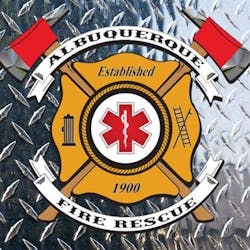NM Department Takes Action Against Cancer
Nov. 28 -- ALBUQUERQUE, NM -- Fires, hazmat incidents, medical calls, car crashes and other types of rescues keep Albuquerque firefighters busy around the clock.
It’s an inherently dangerous job that requires protective equipment. After all, they run into burning buildings. Yet, more and more firefighters are fighting a particularly insidious foe: cancer.
Cancer is now the leading cause for line-of-duty deaths among firefighters across the country, according to the International Association of Firefighters.
And with eight active members of Albuquerque Fire Rescue fighting various forms of cancer, the department is taking steps to keep that number from increasing.
Albuquerque Fire Rescue Chief Paul Dow on Tuesday called cancer “an epidemic in the fire service.”
“Today’s structure fires are more dangerous than ever before,” Dow said. “Although we don’t have as many structure fires as we did maybe 20 or 30 years ago, the fires we respond to burn hotter and faster because of the fuels inside. Now you’re looking at synthetics and plastics, and they burn at a higher temperature and give off acrolein, benzene, hydrogen cyanide, carbon dioxide and deadly carcinogens that our firefighters are exposed to. That’s what is killing our firefighters.”
Standing in front of Ladder Truck 4 during a news conference on Tuesday, Dow and Mayor Tim Keller detailed procedures the department is implementing in an effort to prevent cancer among firefighters.
Keller cited a national statistic that cancer has caused 61 percent of the career firefighter line-of-duty deaths in the country from Jan. 1, 2002, to March 31, 2017.
“This hits close to home in Albuquerque as we have eight active firefighters, some in their 20s and 30s, who have been diagnosed with cancer,” Keller said.
According to research by the CDC/National Institute for Occupational Health and Safety, firefighters have a 9 percent higher risk of being diagnosed with cancer and a 14 percent higher risk of dying from cancer than the general U.S. population.
With those statistics in mind, city officials and AFR members went to work researching best practices in reducing harmful exposures that firefighters face on a daily basis.
AFR has implemented many of those practices during the last year.
Utilizing around $110,000 from general obligation bond funding, the department is installing space that better separates bays for fire trucks and other vehicles from living quarters to further contain exhaust outside of crew quarters.
The project requires two doors to separate vehicle bays from the firefighters’ living area. Diesel exhaust fumes are a known cancer-causing carcinogen, and utilizing the two-door system lessens the chance of contamination inside the living quarters.
Crews of Fire Station 1 have developed a policy for firefighters to decontaminate their gear and equipment at the fire scene, including brushing off debris and soot from gear and a process to have it cleaned by the department’s Logistics Division.
This is expected to reduce the likelihood of firefighters tracking carcinogens into the fire station. In addition, each fire truck is equipped with wet-wipes for firefighters to clean soot from their faces and necks.
Firefighter T-shirts and pants are also contaminated while responding to a structure fire. In an effort to keep firefighters from taking contaminated clothing home to their families, the department has developed a plan to install washers and dryers in fire stations for members to wash their clothing.
IAFF Local 244 has already secured some of the funding to start the project.
And thanks to an $89,825 state fire protection grant, the department is purchasing 800 new National Fire Protection Association standards-compliant flash hoods and 145 structural helmets, which provide an added level of protection from contaminates.
The department will issue every firefighter a new flash hood, and the remainder will be placed into the flash hood exchange program.
Starting in January, the department will also require each firefighter to complete an annual medical exam rather than every other year.
In days past, and even on some recent movies and television programs, a dirty fire helmet or gear was a badge of honor or courage.
That firefighting culture, Dow said, must change.
“It’s something that I feel we can prevent and do better,” Dow said. “It’s hard to sit there with one of your firefighters and talk to them about the process they are going to do to get treatment, and you know what that road looks like. I’ve sat with our firefighters when they are receiving chemotherapy, and they’re nodding off and trying to recover. It’s terrible and I don’t want to see it again.”
___ (c)2018 the Albuquerque Journal (Albuquerque, N.M.) Visit the Albuquerque Journal (Albuquerque, N.M.) at www.abqjournal.com Distributed by Tribune Content Agency, LLC.
